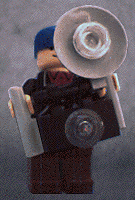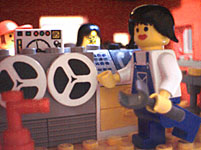Imaging LEGO Models
for the Web
I HAVE TRIED a number of techniques, all of which can still be seen on my pages. I'm sure many people have different methods that work well for them. But here I describe only my experiences. Following links in the text below will bring you to example images.
 When I started out, I used a macro lens and
traditional film for a photo-shoot of some of my models, including the
outdoor stage and the pictures of Eddie's bar. Those were taken in a
professional studio with backdrops and lighting, etc. I worked at
a magazine at that time and my friend was a staff photographer. He helped
me to get set up. Overall, I found it to be a fairly frustrating experience. It
was difficult for me to get even lighting in pictures taken from within the models.
And the models came out much shinier than I wanted them to. Reflections were a
real problem. (I was later told that I could have sprayed my models with a
non-damaging substance which cuts down on the shine.) I also found it difficult to get much depth of field, backgrounds got very bleary.
An experienced photographer would probably have been able to achieve better results
by making adjustments in the film, lighting, and exposure time. LEGO themselves must be using traditional photography and
most of their pictures look really great. But I decided that the traditional route was not for me.
Call me a wimp, but I'm pretty impatient and even just waiting for film to be developed and then having to scan in the pictures, etc.
made it feel like a huge job.
When I started out, I used a macro lens and
traditional film for a photo-shoot of some of my models, including the
outdoor stage and the pictures of Eddie's bar. Those were taken in a
professional studio with backdrops and lighting, etc. I worked at
a magazine at that time and my friend was a staff photographer. He helped
me to get set up. Overall, I found it to be a fairly frustrating experience. It
was difficult for me to get even lighting in pictures taken from within the models.
And the models came out much shinier than I wanted them to. Reflections were a
real problem. (I was later told that I could have sprayed my models with a
non-damaging substance which cuts down on the shine.) I also found it difficult to get much depth of field, backgrounds got very bleary.
An experienced photographer would probably have been able to achieve better results
by making adjustments in the film, lighting, and exposure time. LEGO themselves must be using traditional photography and
most of their pictures look really great. But I decided that the traditional route was not for me.
Call me a wimp, but I'm pretty impatient and even just waiting for film to be developed and then having to scan in the pictures, etc.
made it feel like a huge job.
Many pictures here were taken with a color Quick Cam. It's not
the greatest device for image quality, considering its low resolution and noisy
nature, but it's able to get up very close to the models (within 2
inches) and it's extremely light sensitive. Perfect for placing
-inside- models. It's less expensive than film overall (around $200). And the results are nearly instant (woo-hoo!).
I kept my QC mounted on a tripod next to a small table which I put models on,
making the camera level with the minifigs and only a few inches away. I would
focus the camera while looking at my computer monitor.
 I found the best lighting results to come from the indirect light
of a nearby window. Positioning lamps around the models often
resulted in frustration when lighter colors became overly lit and burned
out while darker areas were sometimes still too dark. Light reflecting
off the white LEGO bricks seemed to be blinding the camera's CCD chip.
Natural light on the other hand, causes a nice even lighting all
around. It can make for a realistic looking light source. This is how my pictures of staff minifigs
inside the Legopolis Online office building were taken.
I found the best lighting results to come from the indirect light
of a nearby window. Positioning lamps around the models often
resulted in frustration when lighter colors became overly lit and burned
out while darker areas were sometimes still too dark. Light reflecting
off the white LEGO bricks seemed to be blinding the camera's CCD chip.
Natural light on the other hand, causes a nice even lighting all
around. It can make for a realistic looking light source. This is how my pictures of staff minifigs
inside the Legopolis Online office building were taken.
Once I have the picture, by using Adobe Photoshop, I can usually
pull out the best parts and knock out the bad. Photoshop's "dust and
scratches" filter removes noisy single-pixel specks like magic. Color
saturation can be increased and hue adjusted. I sometimes do a little "dodging" in the dark areas and
"burning" in the light areas to enhance detail. Finally, I drop the image's
resolution in half and run a sharpening filter.
In rare cases I have taken multiple pictures and combined them as one
within Photoshop. An example of this can be seen on citizen Becky's
page. She was propped up on an angle for the shot with an object which
was replaced with roadplate background from another picture minus Becky
and the propping object.
As soon as I am happy with how an image looks, I save it first as a TIFF file (for an archive copy) and then
as a high quality JPEG for the web.
 My web backgrounds, and all imagery for The Minifig Generator were made by placing LEGO elements directly on a flatbed scanner.
This works fine if you don't need much depth to your images. Depending on the capabilities of the scanner you're using,
you may be able to hold up clarity until a few inches off the surface of the scanner where everything starts to blur out of recognition.
Some examples of my using the scanner for small models include: the catalog of flower arrangements at "Flowers-By-Harry" and my Under Construction symbol. My web backgrounds, and all imagery for The Minifig Generator were made by placing LEGO elements directly on a flatbed scanner.
This works fine if you don't need much depth to your images. Depending on the capabilities of the scanner you're using,
you may be able to hold up clarity until a few inches off the surface of the scanner where everything starts to blur out of recognition.
Some examples of my using the scanner for small models include: the catalog of flower arrangements at "Flowers-By-Harry" and my Under Construction symbol.
These days I use a SONY Mavica with 10x zoom. It's still not my dream camera, but it really works out well for website pictures. It's far faster and takes better quality images than the QuickCam. Not to mention, it's portable! Someday I'll write more about it here.
LEGO® is a trademark of the LEGO Group of companies which does not sponsor, authorize or endorse this site. |